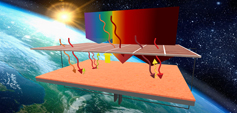Article contents
Upconversion of low-energy photons in semiconductor nanostructures for solar energy harvesting
Published online by Cambridge University Press: 11 January 2019
Abstract

We explore the status of state-of-the-art upconverter materials in the context of improving solar cell performance. We focus on semiconductor upconversion nanostructures that can harvest two separate bands of the solar spectrum and offer a promising path to rational engineering of improved performance and thus improved overall solar energy harvesting.
Photon upconversion is a process in which two low-energy photons are sequentially absorbed and one high-energy photon is emitted. Photon upconversion in both inorganic and organic material platforms has been used to improve solar cell efficiency. Lanthanide-doped salts (inorganic) and triplet–triplet annihilation molecules (organic) have achieved 33% and 60% internal upconversion quantum efficiency, respectively, leading to current density increases of 17 mA/cm2 and 0.86 mA/cm2. However, their performance is limited by their narrow absorption bandwidth (AB) and limited tunability, especially at low photon fluxes. Recently, colloidal semiconductor nanostructures have emerged as a promising material platform for upconversion. The optical absorption in these low-dimensional heterostructures involves both quantum-confined and continuum band states, enabling a much larger AB. Moreover, the techniques of semiconductor heterostructure engineering can be used to optimize performance and to tailor absorption and emission wavelengths. We review the performance and potential impact on solar energy harvesting of upconversion materials, focusing on semiconductor upconverters. We discuss computational models that suggest that semiconductor upconverter nanostructures could have outstanding performance for photovoltaic. We then discuss the current state of the art in semiconductor upconversion morphologies and compositions and provide an outlook on the ways in which nanostructures can be tailored to improve performance for applications.
- Type
- Review Article
- Information
- Copyright
- Copyright © Materials Research Society 2019
References
REFERENCES
A correction has been issued for this article:
- 18
- Cited by
Linked content
Please note a has been issued for this article.


